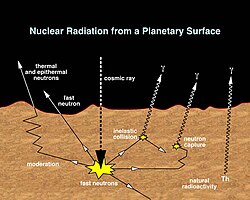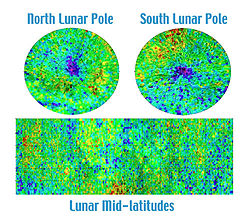Gamma-ray spectrometer

A gamma-ray spectrometer (GRS) is an instrument for measuring the distribution (or spectrum—see figure) of the intensity of gamma radiation versus the energy of each photon. The study and analysis of gamma-ray spectra for scientific and technical use is called gamma spectroscopy, and gamma-ray spectrometers are the instruments which observe and collect such data. Because the energy of each photon of EM radiation is proportional to its frequency, gamma rays have sufficient energy that they are typically observed by counting individual photons.
Gamma-ray spectroscopy

Atomic nuclei have an energy-level structure somewhat analogous to the energy levels of atoms, so that they may emit (or absorb) photons of particular energies, much as atoms do, but at energies that are thousands to millions of times higher than those typically studied in optical spectroscopy. (Note that the short-wavelength high-energy end, of the atomic spectroscopy energy range (few
Astronomical spectrometers
A number of investigations have been performed to observe the gamma-ray spectra of the
and the imaging Ge spectrometer on the RHESSI satellite have been devoted to solar observations.Planetary gamma-ray spectrometers

Gamma-ray spectrometers have been widely used for the elemental and isotopic analysis of bodies in the Solar System, especially the Moon and Mars. These surfaces are subjected to a continual bombardment of high-energy
GRS instruments supply data on the distribution and abundance of chemical elements, much as the Lunar Prospector mission did on the Moon. In this case, the chemical element thorium was mapped, with higher concentrations shown as yellow/orange/red in the left image.
How a GRS works
Some constructions of
When exposed to

By measuring gamma rays coming from the target body, it is possible to calculate the abundance of various elements and how they are distributed around the planet's surface. Gamma rays, emitted from the
Gamma rays and neutrons are produced by cosmic rays. Incoming
Water detection

By measuring neutrons, it is possible to calculate the abundance of hydrogen, thus inferring the presence of water. The neutron detectors are sensitive to concentrations of hydrogen in the upper meter of the surface. When cosmic rays hit the surface of Mars, neutrons and gamma-rays come out of the soil. The GRS measured their energies.[2] Certain energies are produced by hydrogen. Since hydrogen is most likely present in the form of water ice, the spectrometer will be able to measure directly the amount of permanent ground ice and how it changes with the seasons. Like a virtual shovel "digging into" the surface, the spectrometer will allow scientists to peer into this shallow subsurface of Mars and measure the existence of hydrogen.
GRS will supply data similar to that of the successful Lunar Prospector mission, which told us how much hydrogen, and thus water, is likely on the Moon.
The gamma-ray spectrometer used on the Odyssey spacecraft consists of four main components: the gamma sensor head, the neutron spectrometer, the high energy neutron detector, and the central electronics assembly. The sensor head is separated from the rest of the spacecraft by a 6.2 meter (20 ft) boom, which was extended after Odyssey entered the mapping orbit at Mars. This maneuver is done to minimize interference from any gamma rays coming from the spacecraft itself. The initial spectrometer activity, lasting between 15 and 40 days, performed an instrument calibration before the boom was deployed. After about 100 days of the mapping mission, the boom was deployed and remained in this position for the duration of the mission. The two neutron detectors-the neutron spectrometer and the high-energy neutron detector-are mounted on the main spacecraft structure and operated continuously throughout the mapping mission.
GRS specifications for the Odyssey mission

The Gamma-Ray Spectrometer weighs 30.5 kilograms (67.2 lb) and uses 32 watts of power. Along with its cooler, it measures 468 by 534 by 604 mm (18.4 by 21.0 by 23.8 in). The detector is a photodiode made of a 1.2 kg germanium crystal, reverse biased to about 3 kilovolts, mounted at the end of a six-meter boom to minimize interferences from the gamma radiation produced by the spacecraft itself. Its spatial resolution is about 300 km.[3][4]
The neutron spectrometer is 173 by 144 by 314 mm (6.8 by 5.7 by 12.4 in).
The high-energy neutron detector measures 303 by 248 by 242 mm (11.9 by 9.8 by 9.5 in). The instrument's central electronics box is 281 by 243 by 234 mm (11.1 by 9.6 by 9.2 in).
See also
References
- PMID 9727970.)
{{cite journal}}: CS1 maint: multiple names: authors list (link - ^ NASA.gov[dead link]
- S2CID 121206223.)
{{cite journal}}: CS1 maint: multiple names: authors list (link) CS1 maint: numeric names: authors list (link - ^ NASA Space Science Data Coordinated Archive
External links
- NASA Jet Propulsion Laboratory Gamma Ray Spectrometer page
- Mars Odyssey GRS instrument site Archived 2019-05-05 at the Wayback Machine at the University of Arizona
- Apollo 16 Gamma Ray Spectrometer
- NEAR Science instruments (including GRS)
- Lunar Prospector's GRS at NASA Ames Research Center
- Lunar Prospector's GRS at National Space Science Data Center (NSSDC)
